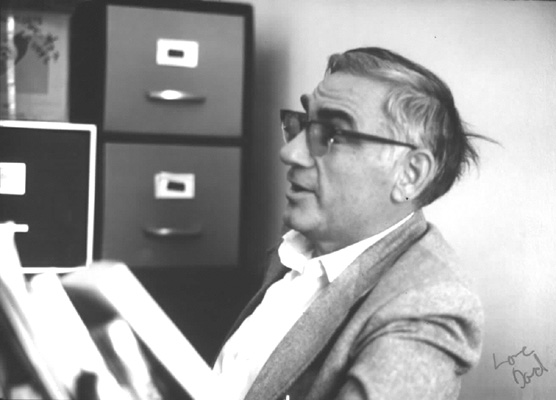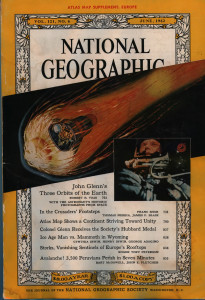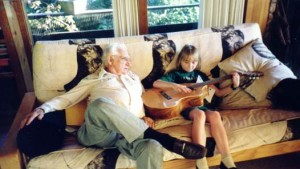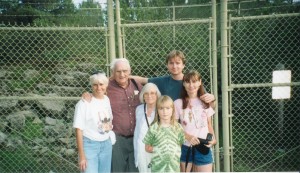George Allen Agogino died at his home early Monday morning, September 11, 2000, after a three-year battle with cancer. He was 79. He came to Portales in 1963 to lead a summer excavation at the Blackwater Draw archeological site; he stayed to create the Department of Anthropology at Eastern New Mexico University, which he chaired for eleven years. He was the founding director of the Blackwater Draw Museum which he designed and found the resources to build. In 1989 he was selected to be a New Mexico Eminent Scholar by the Governor. He retired as Distinguished Research Professor in 1991.
Between graduating from Overbrook High School in Philadelphia, Pennsylvania, in 1940 and volunteering for service in WWII in 1943, he was employed by the Lehigh Valley Railroad Company to examine the accuracy of conductors’ reports. In WWII he was a member of the Signal Service Group in the Southwest Pacific Theater of Operations where he was a high-speed radio operator, sending and receiving code signals. He was also placed on detached service to reconnoiter remote New Guinea villages for Japanese presence. After the Allied occupation of Japan, he was assigned to Tokyo headquarters under General MacArthur.
With a BA in Anthropology and an MA in Sociology from the University of New Mexico, he began his teaching career at Nasson College in Maine. He also taught while he completed his Ph.D. in Anthropology at Syracuse University. His inspiring teaching and prolific research career included positions at the State University of South Dakota, the University of Wyoming, and Baylor University in Waco, Texas. He was also a post-doctoral research appointment at Harvard University. He published more than 600 articles and chaired numerous sessions and presented many papers at professional meetings. While he is best known for his contributions to Paleo-Indian archeology, he had broad interests including the ethnology of the Southwestern U.S.; Mexican archeology, ethnology, and history; forensic physical anthropology, and the supernatural. He was a fellow of the American Association for the Advancement of Science, the American Anthropological Association, and the Royal Anthropological Association of England. He was selected for membership in the Explorers Club in 1980 and for inclusion in Who’s Who in America (1988 to 1997) and Who’s Who in the World (1991-1992).
His selection as a member of the US Olympic track team for the 1940 summer Olympics (canceled due to the war in Europe) was a high point in his athletic career, which included three national high school indoor track team championships at Overbrook High School and organizing and running on the University of New Mexico cross country track team. He combined his exceptional athletic ability with his capacity to lead and inspire to coach college baseball and basketball. He continued to compete in sports, particularly tennis, well into his retirement.
He had a lifelong love of music, which he pursued for over sixty years. He started playing guitar and singing with his strong, beautiful voice at a young age. He played with Pete Seeger in 1946. His most recent musical activity was singing at services at the Central Christian Church.
Dr. Agogino is survived by his wife, Dr. Mercedes Agogino of Portales, N.M.; two daughters, Karen Agogino of Corrales, N.M. and Dr. Alice Agogino of Berkeley, C.A.; a grandson, Dr. Adrian Agogino of San Jose, CA; and a granddaughter, Arianne Agogino Gieringer of Berkeley, CA.
Services were held on Saturday, September 16, 2 PM, at the Central Christian Church of Portales. The family requests that in lieu of flowers, donations be made to the Blackwater Draw Museum. Checks should be made payable to Friends of Eastern Foundation, designated to Blackwater Draw Museum, and sent to: Friends of Eastern Foundation, Station #8, ENMU, Portales, NM 88130.
Related Links
- Dr. George Agogino published over six hundred articles during his lifetime. Many were in the field he is most known for, Paleo-Indian archaeology; but his interests were wide-ranging and included modern and ancient Mexico. See Bibliography
- The Plains Anthropologist had a special issue (Vol. 49, No. 191, August 2004) with memorials to my father. Here is the Memorial by C. Vance Haynes, Jr.: “In the Field with My Friend and Colleague George A. Agogino”. Later in 2006 (Vol. 51, No. 200), the Plains Anthropologist plublished an article by my father that was edited posthumously by my mother and sister, Mercedes and Karen Agogino, respectively: Reflections on a Half-Century of Dust and Dirt.
- Photos of “College Days” at the University of New Mexico.
- Dr. Agogino was fascinated by “the unexplained” and Cryptozoology. He worked with Ivan T. Sanderson and others to lend his expertise in physical anthropology to analyze evidence of what has been called the Yeti, Big Foot, Abominable Snowman, and Sasquatch. Here is the Forward he wrote for Ivan T. Sanderson’s book Abominable Snowman in 1951. Here is a 1969 article from Argosy Magazine, “The Minnesota Iceman Story”, followed by an article written by then Argosy Science Editor Ivan T. Sanderson titled: “THE MISSING LINK?”The Society for the Investigation of the Unexplained, of New Jersey, U.S.A., May 1969. pp. 23-31. Over the years, as all of the evidence sent to Agogino appeared to be either fraudulent or of some known species, Agogino came to the conclusion that it was unlikely that any such creature could continue to exist now that most of the land masses of the earth have been explored. Dr. Agogino was featured on the “unexplained mysteries” television program with the negative results from DNA analysis of an ancient finger specimen obtained from a monastery in the Himalayas called the “Pangboche Hand”.
- As George Agogino was an archaeology student in the late 1940’s and early 1950’s in New Mexico and had lifetime connections with many ranchers in New Mexico, he was tapped for information concerning the July 1947 “Roswell UFO incident”. Kevin Randle’s book and its updates claim to have received confirmation from George Agogino in regards to the name of the archaeologist doing work near the Plains of San Agustin who reported the incident. George Agogino’s daughter Alice recalls that her father had narrowed the mystery archaeologist down to 3 possible candidates, the son of one told him on his deathbed that his father could not reveal information for fear of losing government contracts. Alice Agogino says that her father never had any first hand knowledge that any one of his candidates was indeed the one reported to have been involved with the Roswell incident.
- George Agogino was a friend and admirer of Oscar Howe, a Sioux Indian artist and emeritus professor of Art History at the State University of South Dakota, where Agogino was an assistant professor. Agogino wrote an article about Howe in 1957 (with Heidi Howe) reprinted from the Institute of American Indian Studies’ News Report.
- Dr. Agogino was Co-Director of the Mammoth Pit excavation while an assistant professor at the University of Wyoming and written up in National Geographic Magazine, vol. 121, no. 6, 1962.
- In the 1960’s, Dr. Agogino was Co-PI and Co-Director (with Dr. Cynthia Irwin-Williams and Henry Irwin) of the Hell Gap archaeological site “represents one of the most famous (if not the most significant) Paleoindian sites in North America.” The diagnostic artifacts found in stratigraphic sequence at Hell Gap confirmed and cemented the classic Plains Paleoindian cultural chronology still used for all intents and purposes today.” Hell Gap continues to be excavated today. See: Hell Gap expanding Paleoindian history (2013).
- Dr. Agogino’s research in the archaeology of early humans of the Rocky Mountains and the Southwest led to lifetime collaborations with paleo-geologist Vance Haynes, Marie Wormington, the Irwin archaeology family, former student Dennis Stanford, cultural anthroplogist Ruth Underhill and many other prominent geologists, anthropologists and archaeologists.
- Dr. Agogino was the founding Chair of the Anthropology Department at ENMU in 1963 and in 1968 became the founding Director of the Blackwater Draw Museum, located midway between Portales and Clovis, New Mexico. Dr. Agogino began excavation of the Blackwater Draw archaeology site in 1963. Many bison, mammoth and ground sloth bones were uncovered, along with stone tools and the oldest hand-dug well found in the Americas. The Blackwater Draw Site has received national recognition and funding from the Carnegie Institute, Smithsonian Institution, Academy of Natural Sciences, National Science Foundation, United States National Museum and the National Geographic Society. It was incorporated into the National Register of Historic Places in 1982, and has more recently been declared a National Historic Landmark.
- A Star Trek fan, George Agogino wrote Desilu Studios in Hollywood if he could obtain the spears used in a January 1967 episode titled “The Galileo Seven” for display of the newly built Blackwater Draw Museum. The spears seemed to be based on Robert H. Justman, Associate Producer of Star Trek at the cost of shipping. The spears are displayed periodically at the Blackwater Draw Museum between Portales and Clovis, New Mexico, under the direction of Eastern New Mexico University.
- George Agogino’s Forward to “The Ceremonialism of the Tepecan,” John Alden Mason (of University of Pennsylvania), Eastern New Mexico University Contributions in Anthropology, Vol. 4, No. 1, October 1972. (Ed., C. Irwin-Williams). Agogino grew up in a poor neighborhood in Philadelphia and was the only student in his high school to graduate from college. George credits Alden Mason with starting him on the road to “fame and poverty” in anthropology.
- “Tracing John Reed’s 1914 Desert Route: The Haciendas,” Bobbie Ferguson and George Agogino, Eastern New Mexico University Contributions in Anthropology, Vol. 10, No. 1, 1979. (Note to daughter Alice saying he is worried that she is working to hard.)
- Dr. Agogino wrote this memoir in honor of Franklin Folsom, author of books on archaeology and many other subjects. Agogino worked with Folsom on research regarding George McJunkin, the African American cowboy who now is known for having discovered the initial Folsom site near Folsom, N.M.
- Redated Sandia Cave in 1986: Haynes and Agogino (1986) give a table of radiocarbon dates done by them, ranging from 11,850 to 13,700 radiocarbon dates BP.
- Last Train From Cuernavaca, from feature article in the Clovis News Journal, Section C, Sunday, Nov. 6, 1994. (Daughter Alice Agogino also spoke with the wife of Pancho Villa, who was one of the contacts for the story described.)
- Photo (above) of George and Family (left to right, Mercedes, George, Alice, Arianne, Adrian and Karen) at Blackwater Draw Museum, 1996.
- Photo (above) of George Agogino teaching granddaughter, Arianne Agogino Gieringer, how to play the guitar, 1997.
- Visit to Agogino Cave, Spring 1999. Agogino Cave was named over thirty years ago after my father. As the cave has never been fully excavated (other than the graduate work of Mike Kunz), the Bureau of Land Management (BLM) tries to keep the cave a secret and restricts access. In Spring ’99, my family decided to revisit this historic site with my father. Even with the BLM’s topographic map, it was difficult finding the cave as the road to it had been washed out and was never repaired. It was also carefully guarded by a rattlesnake, which almost got my son, Adrian Agogino. He managed to escape by means of a dramatic backward jump over the top ceiling of Agogino Cave.
- George Agogino contributed personal possessions to museums and articles and tributes to archives, including the National Anthropological Archives in the National Museum of Natural History of the Smithsonian (e.g., Marie Wormington papers, the Alfred Whiting papers, and the Carlton Coon papers), the American Philosophical Society (e.g. John Alden Mason papers) and the Maxwell Museum and Blackwater Draw Museums at Eastern New Mexico University.
Last updated by Alice M. Agogino, 29 Dec. 2015




